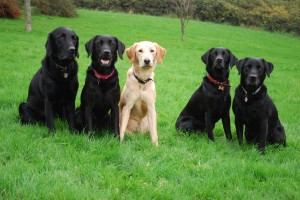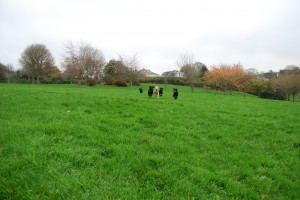Is your dog over excitable?
When spending time training your dog it can become clear that some dogs can be harder to get to grips with, if they are not tuned into their owner and just running around like a loony!
The first thing to address with a dog that does seem to be a little bit more than just a happy dog but what I would call “wired” is to look at the type of dog food you use. The key element is to look at the protein. When a dog receives too much protein it “can” make them a bit loopy. I would prefer to have a protein content of around 20%.
A dog that is over excitable can seem out of control, can be leaping around, jump on people or children. If a dog is bombed out it could lead to trouble such as lashing out unpredictably. The vast majority of dogs that over excitable are dogs that need to learn how to slow down. Slow down long enough to use their brains! If a dog can then use its head their energy can be channelled more appropriately. You need to enable your dog to tune in to YOU! This can be done by a variety of means.
If you are trying to train your dog knowing you have an uphill battle with a dog that is going a bit daft all the time then you need to try and get rid of some of the excess energy. This helps a dog to then focus on what it needs to do, rather than struggling to train a dog that cannot concentrate this can make things worse. (as in theory you are then detuning any good behavioural steps you had made if he is not sitting when asked). So the second step is in playing/exercising with your dog before any training commences.
Is the excitement down to attention seeking in which case – patience & ignoring are your key elements to follow. You must wait for the desire behaviour with minimum interaction with your dog to achieve your aim.
Does your dog constantly leap to try and seek eye contact? This is there way of saying “me me me me”. To me this is not a desired behaviour and needs to be sorted out by blocking your dogs eye contact with you, by raising your arms then plant your dog into a sit (one hand on its bottom pushing down, the other hand on the collar). Do not look at your dog. If necessary put your dog on the lead to do this. Continually put the dog into a sit and do not even talk to the dog. If a dog jumps and makes body contact then it is important to say NO! loudly and place the dog into a sit to confirm to the dog you are in control.
Hopefully you will be able to gain control of your dog if you consistently KEEP putting the dog into a sit every single time it moves out of the sit put the dog back into a sit. By being persistent, positive acts will result in your dog gaining respect for you. They will feel happier for having a pack leader to look up to.
Over excitement can be very trying, as the focus is not on you but everything surrounding the dog which does make it very hard to get your dog to look at you. Basically another reason for this is that the dog knows it can get away with the bad behaviour. Correct any bad behaviour and if you are struggling reduce the expectation level to an obtainable goal. Once the goal is reached you can then broaden your expectations.
I think it is always a good starting point to go back to basics when you are finding something to be a problem.
You need to consider that if you are asking for a sit/stay from an over-excited dog, are they able to do this off the lead, is this a fair request? It is unlikely to be achieved off lead so make the process a step easier for the dog thus making it achievable to prevent bad habits forming.
With your dog on a lead, place them in a sit and keep putting the dog back into a sit until you are satisfied a nice steady sit has been achieved. Patience and Consistency are the words you need to remind yourself of. Don’t talk to the dog but keep repeating the act of placing him/her into a sit. After a while the dog will become bored and will learn that sitting quietly works better than playing the fool.
If necessary when placing them into a sit, hold on to the collar as this will re-enforce that you are wanting the dog to be still. A dog is far happier when it wants to please its owner. If they are too excited to even be able to think then they wont get the most of a walk as they will be spending a lot of time in the company of a very frustrated owner! A dog needs to be comfortable in its own skin, not pace around all the time. So it is important to make that step of teaching your dog how to be still. There is no force in the method but consistency (ie repetition ) is what does enable your dog to get an idea of what is required.
Once the dog has settled only then can you consider your next move and that could be heelwork. Take your dog for a little walk, in the shape of a square, keeping your dog to the left of you. The aim of this exercise is to get your dog to focus on you. Your dog is not going to have any idea the direction you are walking him in, he will soon realise that you are going this way and that so he has to pay attention to you to get it right.
Heelwork will require a certain amount of checking. Again consistently correct the dogs position – he must not be more than one pace ahead of you as his nose should be by your leg, with you having a nice slack lead. See video clip
The aims of these exercises is for your dog to learn how to be still, this will give him the time to use his head and actually think! The second aim is to then get to the stage where the dog is focussed on its owner.
Once the basics are in place most things will fall into place. If a dog knows it can’t get away with bad behaviour then he is far less likely to continue trying to play you up.
There is little point in doing a training session if you know you are going to ask your dog to sit, give up when the dog runs off as this will not help for the future session. You must always have a positive training session if you can – short and sweet if all is not going to plan. End a session with something you know your dog can do!
Other ideas which can help your dog focus on you, using tools such as food treats, toys – ball games, squeaky toys any thing which can help with distracting a dog that is looking everywhere but at you. Be warned of not relying on these tools as you may run out of treats or lose the toy.
Rewarding an overexcited dog.
A dog has to learn not to over react to praise. You have dogs that are so laid back that even geeing them up with over the top praise will not create a stir! Dogs that are a bit bombed out on any attention I would only want to give very low key praise to. As it could induce a moment of madness if the dogs becomes over-excited again. I would be inclined to stroke the dog gently on the head or along its body with the gentle praise of good boy in a soothing voice. Don’t stroke him vigorously or use an excited voice!
Conclusion:
“If it takes all day, it takes all day!” I say this loosely as training sessions should always end on a positive note. I am trying to convey that if you ask a dog to do something you must then follow the request through to a positive conclusion. Don’t give in to sloppy standards and raise the bar when you know your dog can handle it!
Remember all training sessions should end on a good note and preferably be short broken up sessions.
Have faith in your dog and believe you CAN achieve better behaviour, set achievable goals which can then be worked upon!

Sit …. Stay

Stay at a Distance…recall!